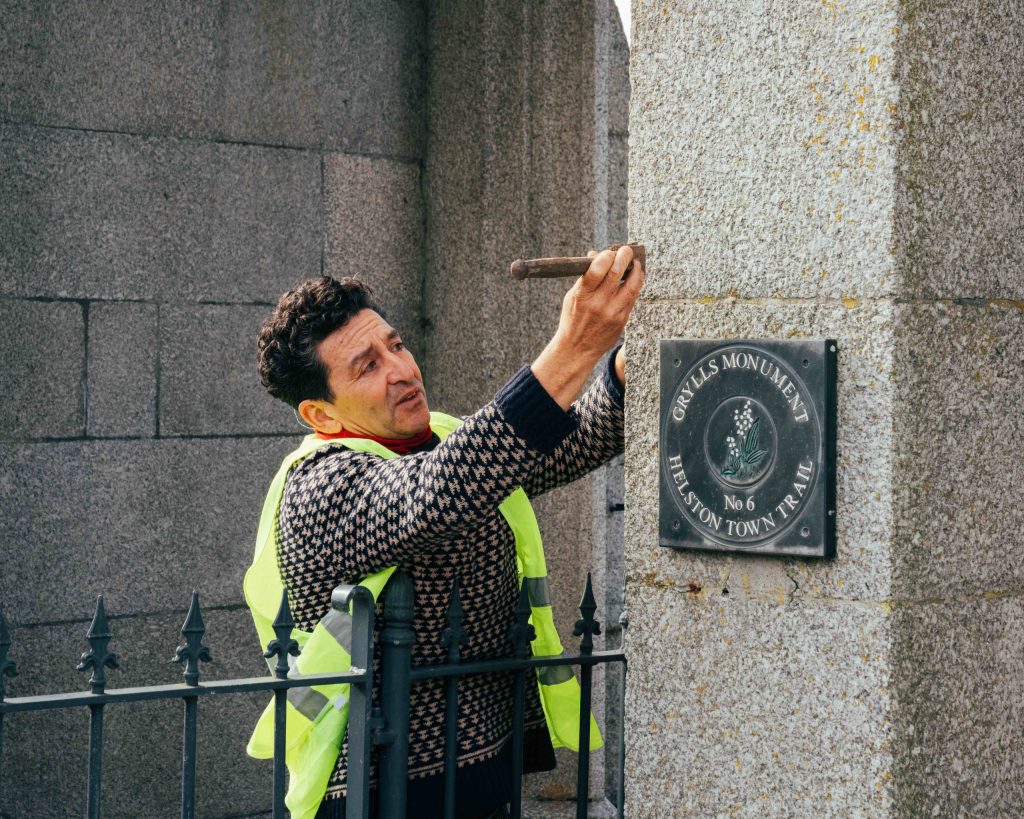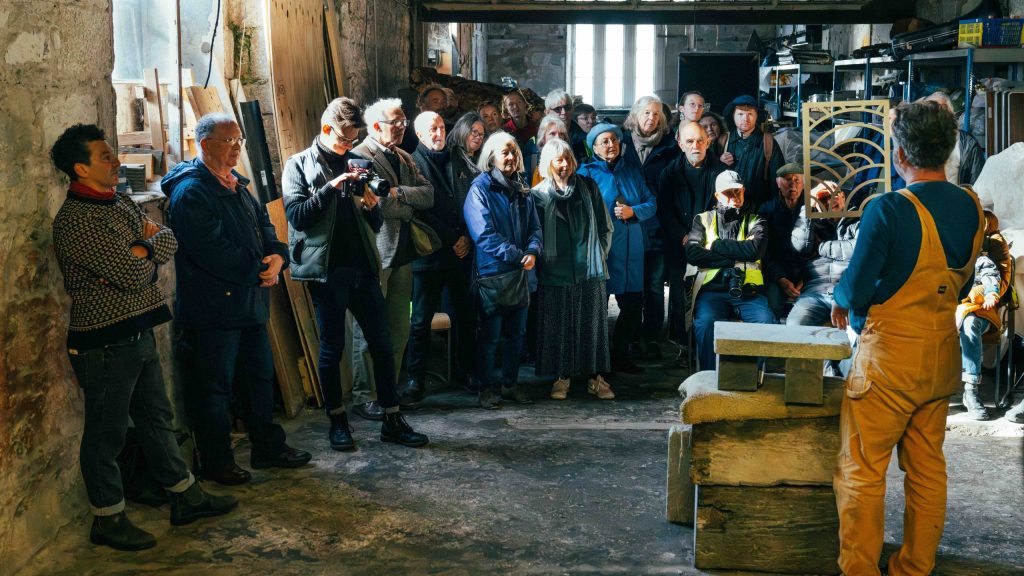In October 2023 CAST hosted the second Water and Stone programme, a three-day celebration of granite, exploring the geological formation of the stone and its impact on landscape and built heritage, as well as the ways in which it is shaped by human industry and in turn shapes the lives of those who live and work with it. Water and Stone (Dowr ha Men in Cornish) was led by sculptor, Senior Lecturer at Falmouth University and granite enthusiast Dr David Paton. Recordings of the talks and of The Mason’s Mark walk, in central Helston, can be found on CAST’s YouTube channel and on the project pages here.
On Friday morning mason Jamie Pharoah demonstrated granite dressing and carving for students from Helston Community College.
On Friday evening urban geologist Dr Ruth Siddall gave the keynote talk, The Shape of Granite, in which she addressed the concept of shape as applied to bodies of granite, their constituent crystals, and how these features lead to their being further worked to form sculpture and building stones.
On Saturday morning there were two walks: Reading in Place, a coastal walk devised and led by artist Bronwen Buckeridge, which setting out from Rinsey car park at 10am, and The Mason’s Mark, walk in central Helston led by Ruth Siddall and David Paton, setting out from CAST, 10.30am.
On Saturday afternoon a programme of talks brought together specialists in geology, archaeology, cultural geography, film-making and traditional artisanal skills.
Dr David Paton offered an introduction reflecting on the notion of fluidity and solidity as it relates to water and stone, and including a short review of the morning’s exploration of tooling marks found on granite buildings and structures in Helston.
Dr Beth Simons, Cornish granite specialist and geologist working in disaster response, presented In the Pluton Attic – an analysis of some of the geological features of the Tregonning Granite roof zone. Situated on the coastline between Rinsey and Megiliggar, this is a world class exposure of a pluton roof zone loved by granite geologists.
Dr Rose Ferraby, archaeologist and artist, presented A Stone in Time – offering insights into an archaeological approach to unearthing narratives of people and stone from the subsurface, and ways of storying our landscapes.
Helen Bowkett, Cornish hedger and co-founder of the Cornwall Rural Education and Skills Trust will presented Life on the Hedge – a journey through time, from the practices of the earliest hedge builders to contemporary Cornish Hedge making.
Rachael Jones, artist-filmmaker and researcher, will present Understanding change through filmmaking – an exploration of a filmmaking practice as a means of opening up new ways of knowing our environment.
Dr Caitlin DeSilvey, Professor of Cultural Geography at the University of Exeter presented Making Monuments: The Tolmen Stone – a brief history of heritage legislation in England, told from the perspective of a giant granite boulder.
Granite splitting and carving demonstrations by sculptor and mason took Stéphane Rouget took place throughout the day on Saturday at Helston Town Band Room. CAST’s Saturday Art Club visited the demonstrations and tried out the basic technique for carving stone.
The programme also included specially devised walks led by artists and geologists in Helston and environs, free demonstrations of granite dressing and carving, and a pigment workshop.
On Sunday morning there were two walks: Reading in Place, a coastal walk devised and led by artist Bronwen Buckeridge, which setting out from Rinsey car park at 10am, and On Softer Ground, a walk with artist and granite enthusiast David Paton and geologist Beth Simons from Godolphin to Tregonning Hill.
On Sunday afternoon the programme concluded with a pigment workshop at CAST led by Ruth Siddall.
Water and Stone/Dowr ha Men was made possible by the support of Falmouth University, with FEAST, Cornwall Council, Arts Council England, Cornwall Community Foundation and Helston Town Council. The project was also part-funded by the UK Government through the UK Shared Prosperity Fund.
Dr Ruth Siddall is a geologist specialising in the study of minerals and rocks used in cultural heritage. She has worked extensively on the characterisation and analysis of artists’ pigments, ceramics and building materials, including mortars, bricks and stone. She is a co-author of The Pigment Compendium and is actively engaged in earth science related outreach. She is currently collaborating in research studying materiality with colleagues at UCL Slade School of Fine Art. She regularly leads guided walks unveiling the geological sources of London’s built heritage.
Dr David Paton is Senior Lecturer at Falmouth University. He has been a practising artist and stone sculptor since 1997, and for many years worked extensively on public art projects. Soon after moving to Cornwall in 2005 David started working with Trenoweth Dimensional Granite Quarry near Falmouth, where his deep affinity for the material and people led him to start a PhD titled The Quarry as Sculpture: The Place of Making (2015).
Bronwen Buckeridge is a CAST studio artist and Falmouth University lecturer. She works with field recording, performative events, installation and text. Recent projects include a live pigeon race, a crochet machine directed by birds and an earthwork made with the assistance of witches.
Dr Beth Simons is a Cornish geologist who has written a number of publications on the mineralogical and geochemical variation of granites in southwest England, including the relevance for extraction of critical metals for the low carbon economy, such as lithium. Since 2017 she has worked for INGOs and a UN agency in humanitarian shelter response to disasters and conflict.
Helen Bowkett is a co-founder of Cornwall Rural Education and Skills Trust, and has practiced in Cornish Hedging since 2010. She has a background in craft, boatbuilding and outdoor education, became highly aware of the possible disappearance of important rural crafts. It was from this understanding that the CREST project was initiated.
Dr Rose Ferraby is an archaeologist and artist based in North Yorkshire. Her work often explores the relationship between people and landscape through time. She is interested in how to tell different stories about the past and to inspire people to imagine past worlds. She does this through a range of work: projects with museums and heritage organisations, writing and presenting for radio, illustrating and designing books. She enjoys collaborations that bring together different skills and approaches and offer new ways of understanding our relationship with the Earth.
Rachael Jones is an artist-filmmaker and researcher whose practice often involves others in the filmmaking process – her films are made up of multiple playful assemblages that rely on collaboration. Interested in what can come out of research, embodiment and participation in the landscape, Rachael’s films retain traces of process-driven interactions. She is involved in land-based, alternative and sustainable practices, using found materials and handmade processes where possible.
Prof. Caitlin DeSilvey is a geographer whose research explores the cultural significance of change and transformation, with a particular focus on heritage ecologies and climate futures. Caitlin is based at University of Exeter’s Penryn Campus. She has worked with artists, archaeologists, environmental scientists and heritage practitioners on a range of interdisciplinary projects. She often uses visual imagery and story-telling to engage people in imagining changing environments and places, and look to patterns from the past to try to understand what the future might bring.
Stéphane Rouget is a sculptor and granite carver based at Trenoweth Quarry. Originally from Brittany, Stéphane has developed a deep affinity for granite and has produced a wide range of sculptural and artisanal works across Cornwall and Brittany.
Jamie Pharoah is a full time granite mason at Trenoweth Quarry and works daily with T. Marsh Ltd to produce architectural and artisanal granite work.




